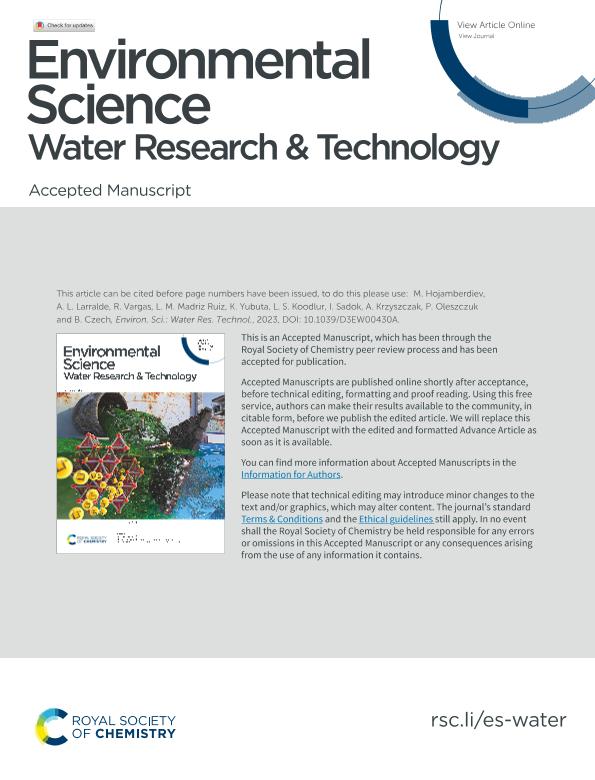Mostrar el registro sencillo del ítem
dc.contributor.author
Hojamberdiev, Mirabbos

dc.contributor.author
Larralde, Ana Laura

dc.contributor.author
Vargas Balda, Ronald Eduardo

dc.contributor.author
Madriz Ruiz, Lorean Mercedes

dc.contributor.author
Yubuta, Kunio
dc.contributor.author
Sannegowda, Lokesh Koodlur
dc.contributor.author
Sadok, Ilona
dc.contributor.author
Krzyszczak Turczyn, Agnieszka
dc.contributor.author
Oleszczuk, Patryk
dc.contributor.author
Czech, Bożena
dc.date.available
2023-12-20T13:01:21Z
dc.date.issued
2023-09
dc.identifier.citation
Hojamberdiev, Mirabbos; Larralde, Ana Laura; Vargas Balda, Ronald Eduardo; Madriz Ruiz, Lorean Mercedes; Yubuta, Kunio; et al.; Unlocking the effect of Zn2+ on crystal structure, optical properties, and photocatalytic degradation of perfluoroalkyl substances (PFAS) of Bi2WO6; Royal Society of Chemistry; Environmental Science: Water Research and Technology; 9; 11; 9-2023; 2866-2879
dc.identifier.issn
2053-1400
dc.identifier.uri
http://hdl.handle.net/11336/220880
dc.description.abstract
Bismuth tungstate (Bi2WO6) with a layered structure and visible light response exhibits excellent photocatalytic activity. To enhance its photocatalytic activity for the degradation of perfluoroalkyl substances (PFAS), Zn2+ is partially substituted for Bi3+ in the Bi2WO6 lattice in this study. Particularly, the effect of Zn2+ content (0-22.5 at%) on the crystal structure, optical property, and photocatalytic activity for the photodegradation of PFAS of Bi2WO6 is investigated. According to the Le Bail fits, the unit-cell volume is slightly reduced from 487.7 Å3 to 480.8 Å3 by the partial substitution of smaller Zn2+ (0.74 Å for CN = 6) for larger Bi3+ (1.03 Å for CN = 6) in the Bi2WO6 crystal lattice, and the solubility of Zn2+ in the Bi2WO6 lattice is found to be below 17.5 at%. The partial substitution of Zn2+ influences the self-aggregation of nanoparticles, Ostwald ripening, and self-organization of nanoplates, resulting in different morphologies. Although the optical bandgap energy of Bi2WO6 is not significantly altered upon the partial substitution of Zn2+, the conduction and valence bands simultaneously shift upward. Among the Bi2−xZnxWO6+δ photocatalysts, 2.5 at% Zn2+-substituted Bi2WO6 exhibits larger water oxidation photocurrent density (0.316 mA cm−2 at 1.23 VRHE) and the highest photocatalytic activity for the photodegradation of PFHxA (k1 = 0.012 min−1). The trapping experiments confirm that the photo-excited holes (h+) and superoxide radicals (O2˙−) are the major reactive species involved in the photodegradation of PFHxA. Liquid chromatography quadrupole time-of-flight mass spectrometry (LC-QTOF/MS) reveals that decarboxylation and defluorination are the main possible routes for the photodegradation of PFHxA over Bi2−xZnxWO6+δ photocatalysts. Our findings suggest that the partial Zn2+-to-Bi2+ substitution can enhance the photocatalytic activity of Bi2WO6 for the degradation of PFAS.
dc.format
application/pdf
dc.language.iso
eng
dc.publisher
Royal Society of Chemistry

dc.rights
info:eu-repo/semantics/openAccess
dc.rights.uri
https://creativecommons.org/licenses/by-nc-sa/2.5/ar/
dc.subject
BI2WO6
dc.subject
PFAS
dc.subject
ZINC
dc.subject
WATER PURIFICATION
dc.subject
PHOTOCALAYSIS
dc.subject
CRYSTAL STRUCTURE
dc.subject.classification
Ingeniería de los Materiales

dc.subject.classification
Ingeniería de los Materiales

dc.subject.classification
INGENIERÍAS Y TECNOLOGÍAS

dc.title
Unlocking the effect of Zn2+ on crystal structure, optical properties, and photocatalytic degradation of perfluoroalkyl substances (PFAS) of Bi2WO6
dc.type
info:eu-repo/semantics/article
dc.type
info:ar-repo/semantics/artículo
dc.type
info:eu-repo/semantics/publishedVersion
dc.date.updated
2023-12-19T12:16:33Z
dc.identifier.eissn
2053-1419
dc.journal.volume
9
dc.journal.number
11
dc.journal.pagination
2866-2879
dc.journal.pais
Reino Unido

dc.journal.ciudad
Cambridge
dc.description.fil
Fil: Hojamberdiev, Mirabbos. Technishe Universitat Berlin; Alemania
dc.description.fil
Fil: Larralde, Ana Laura. Consejo Nacional de Investigaciones Científicas y Técnicas; Argentina. Instituto Nacional de Tecnologia Industrial. Gerencia Operativa de Desarrollo Tecnologico E Innovacion. Sub Gerencia Operativa de Energia y Movilidad.; Argentina
dc.description.fil
Fil: Vargas Balda, Ronald Eduardo. Universidad Nacional de San Martin. Instituto Tecnologico de Chascomus. - Consejo Nacional de Investigaciones Cientificas y Tecnicas. Centro Cientifico Tecnologico Conicet - la Plata. Instituto Tecnologico de Chascomus.; Argentina
dc.description.fil
Fil: Madriz Ruiz, Lorean Mercedes. Universidad Nacional de San Martin. Instituto Tecnologico de Chascomus. - Consejo Nacional de Investigaciones Cientificas y Tecnicas. Centro Cientifico Tecnologico Conicet - la Plata. Instituto Tecnologico de Chascomus.; Argentina
dc.description.fil
Fil: Yubuta, Kunio. Kyushu University; Japón
dc.description.fil
Fil: Sannegowda, Lokesh Koodlur. Vijayanagara Sri Krishnadevaraya University; India
dc.description.fil
Fil: Sadok, Ilona. Medical University Of Lublin (medical University Of Lublin);
dc.description.fil
Fil: Krzyszczak Turczyn, Agnieszka. Medical University Of Lublin (medical University Of Lublin); . Maria Curie-Skłodowska University in Lublin; Polonia
dc.description.fil
Fil: Oleszczuk, Patryk. Medical University Of Lublin (medical University Of Lublin); . Maria Curie-Skłodowska University in Lublin; Polonia
dc.description.fil
Fil: Czech, Bożena. Medical University Of Lublin (medical University Of Lublin); . Maria Curie-Skłodowska University in Lublin; Polonia
dc.journal.title
Environmental Science: Water Research and Technology
dc.relation.alternativeid
info:eu-repo/semantics/altIdentifier/url/https://pubs.rsc.org/en/content/articlelanding/2023/EW/D3EW00430A
dc.relation.alternativeid
info:eu-repo/semantics/altIdentifier/doi/http://dx.doi.org/10.1039/D3EW00430A
Archivos asociados
